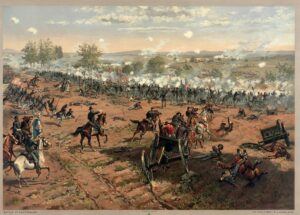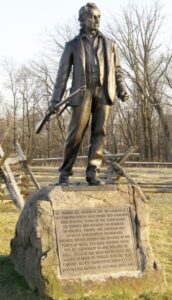
 When things were heating up between the Confederate and Union soldiers around the town of Gettysburg on July 1, 1863, most of the town’s 2,400 civilian residents did their best to make themselves scarce. They didn’t want to find themselves pulled into the conflict on the basis of simply being in the vicinity when the Union needed reinforcements, so they did what they could to get out of the way…either staying shut up in their houses and basements or leaving for someplace calmer.
When things were heating up between the Confederate and Union soldiers around the town of Gettysburg on July 1, 1863, most of the town’s 2,400 civilian residents did their best to make themselves scarce. They didn’t want to find themselves pulled into the conflict on the basis of simply being in the vicinity when the Union needed reinforcements, so they did what they could to get out of the way…either staying shut up in their houses and basements or leaving for someplace calmer.
Not everyone felt that way, however. John Burns, who was about 69 years old at the time, although some said he was older, had fought a half-century earlier in the War of 1812. So, he was no stranger to war, but he took offence with the way a bunch of Rebels had come in and taken over his hometown. When he heard the sounds of battle on July 1, he told his wife he wanted to see what was going on. Grabbing his old flintlock musket, Burns left the house. He came across several Union officers and offered his services. The Union soldiers were basically amused by this strange character with his old musket, just showing up to offer to fight with them…and he wasn’t a young man, so that made it all the more strange. Still, Burns would not go away, and when he found a wounded soldier who would no longer need his rifle, Burns picked it up, and as the fighting heated up, Burns calmly took position behind a tree and began firing at the advancing Confederates. I guess the Union soldiers figured out pretty quickly that he meant business…especially when he was wounded three times in the intense fighting that day, and he still wouldn’t quit. One soldier recalled, “It must have been about noon when I saw a little old man coming up in the rear… I remember he wore a swallow-tailed coat with smooth brass buttons. He had a rifle on his shoulder. We boys began to poke fun at him as soon as he came amongst us, as we thought no civilian in his senses would [put] himself in such a place…”
The soldier then went on to say, “[When asked what] possessed him to come out there at such a time, he replied that ‘the rebels had either driven away or milked his cows, and that he was going to be even with them.’ About this time the enemy began to advance. Bullets were flying thicker and faster, and we hugged the ground about as close as we could. Burns got behind a tree and surprised us all by not taking a double-quick to the rear. He was as calm and collected as any veteran on the ground…I never saw John Burns after our movement to the right, when we left him behind his tree, and only know that he was true blue and grit to the backbone and fought until he was three times wounded.”
I’m sure it really upset the soldiers when they were forced to leave the injured Burns behind as they were ordered to retreat through the town. Burns was then found by the Confederates. Of course, since he had no uniform, they didn’t know that he wasn’t just a civilian who had been caught in the crossfire. Had they known he was fighting against them, they might have executed him, but a wise Burns had gotten rid of his weapon and pretended to be that helpless, unfortunate civilian who had been passing by at the wrong time. So, the Confederate surgeons treated him, and he was allowed to return home. The Confederates were none the wiser, and Burn had exacted his revenge. Burns was a happy man, because it just doesn’t get any better than that!!

 So impressed were the Union soldiers with John Burns, that his story was told to their superiors, and Burns is now memorialized with a statue on the Gettysburg battlefield, and his valor was called out in an after-action report by Major General Abner Doubleday. The memorial reads: “My thanks are specially due to a citizen of Gettysburg named John Burns who although over 70 years of age shouldered his musket and offered his services to Colonel Wister, One Hundred and Fiftieth Pennsylvania Volunteers. Colonel Wister advised him to fight in the woods as there was more shelter there but he preferred to join our line of skirmishers in the open fields. When the troops retired he fought with the Iron Brigade. He was wounded in three places.” John Burns truly was a civilian hero, but the real moral of the story is “Don’t mess with the cows.”
So impressed were the Union soldiers with John Burns, that his story was told to their superiors, and Burns is now memorialized with a statue on the Gettysburg battlefield, and his valor was called out in an after-action report by Major General Abner Doubleday. The memorial reads: “My thanks are specially due to a citizen of Gettysburg named John Burns who although over 70 years of age shouldered his musket and offered his services to Colonel Wister, One Hundred and Fiftieth Pennsylvania Volunteers. Colonel Wister advised him to fight in the woods as there was more shelter there but he preferred to join our line of skirmishers in the open fields. When the troops retired he fought with the Iron Brigade. He was wounded in three places.” John Burns truly was a civilian hero, but the real moral of the story is “Don’t mess with the cows.”


Leave a Reply